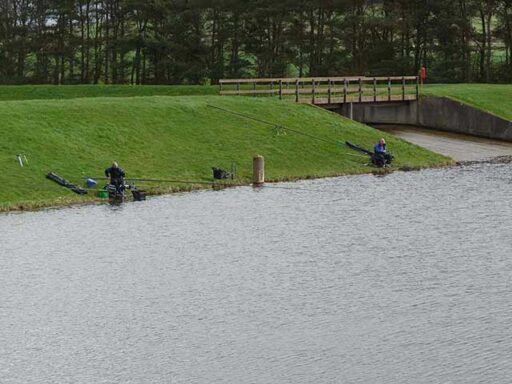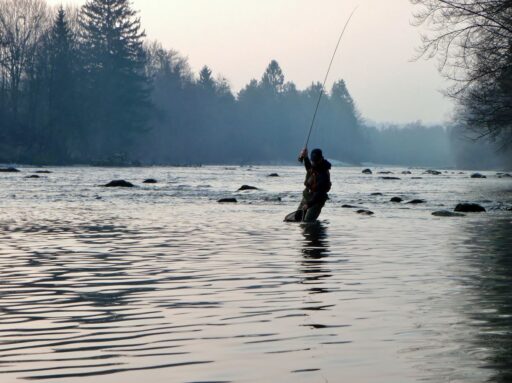Ice fishing is a unique and challenging sport that requires specialized gear, particularly when it comes to the rod tip-up. A good ice fishing rod tip-up can make the difference between a successful outing and a fruitless one. This essential guide is designed to help anglers of all levels select the best ice fishing rod tip-up, taking into account the specific demands of the sport and the variety of lines, reels, rods, baits, and lures available. With the right knowledge and tools, your next ice fishing adventure can be both enjoyable and productive.
Key Takeaways
- Ice fishing lines must be engineered to perform in extreme conditions, offering suppleness and manageability even in freezing temperatures.
- Choosing the right ice fishing rod involves considering length, power, material, and the species of fish targeted, ensuring optimal performance.
- Tip-ups play a crucial role in ice fishing success, with modern features and technologies enhancing their effectiveness and ease of use.
- The integration of rod and reel combos with tip-ups, along with essential reel accessories, can significantly impact your ice fishing style and outcomes.
- Selecting appropriate baits, lures, and rigs for the specific ice conditions and targeted fish species can greatly influence the success of your ice fishing excursions.
Understanding Ice Fishing Line Characteristics

The Importance of Line Flexibility and Memory
When selecting a line for ice fishing, the flexibility and memory of the line are crucial factors. Flexibility ensures that the line can withstand the harsh, cold conditions without becoming brittle or breaking. A line with low memory is preferred as it reduces the likelihood of coiling and tangling, which can impede lure action and lead to missed strikes.
The right line characteristics can make a significant difference in your ice fishing success, providing a more natural presentation and increasing your chances of detecting and setting the hook on a fish.
Here’s a quick overview of the types of lines and their key attributes:
- Monofilament Line: Offers stretch and forgiveness, suitable for finicky fish.
- Fluorocarbon Line: Provides near invisibility and enhanced sensitivity.
- Braided Line: Delivers strength and durability with minimal stretch.
Each type of line has its own set of advantages that can be matched to the specific conditions and target species encountered in ice fishing. It’s important to consider these characteristics to ensure you have the best possible setup for your tip-up.
Visibility and Strike Detection Under Ice
In the icy depths, visibility and the ability to detect strikes are paramount for a successful catch. High-visibility lines are essential as they allow anglers to monitor line movement, which is crucial in the low-light environment under the ice. These lines are specially treated to resist water absorption and ice buildup, maintaining their flexibility and ease of handling.
Our lines are engineered to meet the extreme demands of ice fishing, with low-memory formulations that reduce coiling and tangling. This ensures a natural and enticing presentation, which is key to triggering strikes from cautious fish. The following list highlights the key features of different line types:
- Monofilament: Offers stretch and forgiveness, suitable for finicky biters.
- Fluorocarbon: Provides near invisibility and enhanced sensitivity.
- Braided: Delivers strength and durability with minimal stretch.
Selecting the right line for the conditions and targeted fish species is a critical step in ice fishing. It’s not just about the strength to pull fish through the ice, but also the sensitivity to feel the lightest nibble.
Comparing Monofilament, Fluorocarbon, and Braided Lines
When selecting the best ice fishing line, anglers must consider the unique properties of monofilament, fluorocarbon, and braided lines. Monofilament lines are valued for their stretch and forgiveness, making them suitable for fish that are easily spooked or when a gentle presentation is required. Fluorocarbon lines, on the other hand, are nearly invisible underwater and offer increased sensitivity, allowing anglers to feel even the most subtle nibbles.
Braided lines stand out for their exceptional strength and durability, which is crucial when targeting larger species through the ice. They have minimal stretch, providing direct feedback from the fish to the angler. However, their visibility can be a drawback in clear water conditions. As noted in a recent review, Fluoro is the most invisible, followed by mono, and then by braid, which is going to be the most visible.
Choosing the right line involves balancing these characteristics against the fishing conditions and targeted species. Each line type has its place in an angler’s arsenal, and understanding their differences is key to ice fishing success.
Here’s a quick comparison to help you decide:
- Monofilament: Stretchy, forgiving, good for finicky fish
- Fluorocarbon: Nearly invisible, sensitive, less stretch
- Braided: Strong, durable, best for heavy catches
Selecting the Right Ice Fishing Rod for Your Tip-Up
Rod Length and Power Considerations
When selecting an ice fishing rod for your tip-up, rod length and power are crucial factors that can significantly impact your fishing experience. Shorter rods offer better maneuverability in tight spaces, while longer rods can provide increased sensitivity and casting distance. The power of the rod, which refers to its resistance to bending, should be matched to the size and species of fish you are targeting.
- Ultra-light to light rods are ideal for panfish and smaller trout.
- Medium rods are versatile and can handle a variety of fish sizes.
- Medium-heavy to heavy rods are best suited for larger species like pike and lake trout.
It’s important to balance these considerations with personal comfort and the specific conditions you’ll be fishing in. A well-chosen rod will enhance your ability to detect bites and set the hook effectively, leading to a more successful ice fishing outing.
Material and Construction: What to Look For
When selecting an ice fishing rod for your tip-up, the material and construction are critical factors that determine the rod’s performance and durability. Ice fishing conditions demand materials that can withstand extreme cold without becoming brittle or losing sensitivity.
- Fiberglass is a popular choice for its durability and flexibility.
- Graphite rods offer greater sensitivity, which is essential for detecting subtle bites.
- Composite materials combine the best of both worlds, providing a balance of sensitivity and strength.
The construction of the rod also plays a pivotal role. Look for solid, one-piece rods or those with secure, well-fitted joints. Quality guides and a comfortable handle are also important for maintaining control and reducing hand fatigue during long fishing sessions.
Additionally, the Best Fishing Rods website is a valuable resource for anglers seeking further guidance on various types of fishing rods, including those designed for ice fishing.
Matching Rods with Targeted Fish Species
Selecting the right ice fishing rod for the species you’re targeting is crucial for a successful outing. Different species require different rod characteristics, such as sensitivity, power, and action. For instance, a rod for panfish should be light and sensitive to detect subtle bites, while a rod for larger species like pike or lake trout needs to be heavier and more robust to handle the fight.
When considering the species-specific rods, it’s helpful to look at the common types available:
- Salmon & Steelhead: Opt for casting or trolling rods designed for the strength and fight of these fish.
- Trout: Spinning rods are preferred for their versatility and ease of use.
- Walleye: Both spinning and trolling rods work well, depending on the technique.
Matching the right rod to your target species not only enhances your chances of a catch but also ensures a more enjoyable and effective fishing experience.
Remember to consider the size and behavior of the fish when selecting your rod. A mismatched rod can lead to lost fish or broken gear, so take the time to choose wisely.
Tip-Up Essentials: Maximizing Your Ice Fishing Success

The Role of Tip-Ups in Ice Fishing
Tip-ups are a quintessential tool in the ice angler’s arsenal, offering a unique method for presenting bait to fish beneath the ice. They allow anglers to fish multiple holes simultaneously, increasing the chances of a catch. Unlike traditional rod and reel fishing, tip-ups signal a bite with a flag that ‘tips up,’ alerting the angler to a potential strike.
With the rise of technology, tip-ups can often be cast aside in favor of the latest and greatest in ice fishing sonar technology and exciting jigging tactics. However, the simplicity and effectiveness of tip-ups continue to make them a valuable asset for anglers targeting species like lake trout and pike.
Tip-ups are not only about the catch; they also provide the opportunity for anglers to engage in a more social fishing experience, as they can set their lines and wait for a strike while enjoying the company of friends and family on the ice.
Features and Technologies in Modern Tip-Ups
The landscape of ice fishing gear is constantly evolving, with modern tip-ups boasting a range of features designed to enhance the angler’s experience. Wireless technology has revolutionized the way anglers approach ice fishing, allowing for remote monitoring of multiple lines. This advancement not only increases the range at which an angler can effectively fish but also improves visibility of strikes, ensuring no catch goes unnoticed.
Tip-ups today come equipped with various innovations such as thermal hole covers to prevent freezing, built-in tackle storage, and adjustable flag tension. These features contribute to a more efficient and enjoyable ice fishing outing.
Additionally, the integration of high-quality materials and user-friendly designs has led to more durable and reliable tip-ups. Anglers can now select from a variety of models that cater to their specific fishing conditions and preferences. Below is a list of key features to consider when choosing a modern tip-up:
- Thermal hole covers to prevent freeze-over
- Built-in tackle storage compartments
- Adjustable flag tension for different fish sizes
- Lightweight and durable construction
- Submersible and weather-resistant designs
- Brightly colored flags for better visibility
The Evolution of Tip-Ups has certainly made ice fishing more accessible and successful. With these advancements, anglers are better equipped to face the challenges of ice fishing and increase their chances of a rewarding catch.
Setting Up and Using Your Tip-Up Effectively
To ensure the performance needed for successful ice fishing outings, setting up your tip-up correctly is crucial. Begin by assembling the tip-up according to the manufacturer’s instructions, ensuring all parts are secure and functional. Next, spool the reel with the appropriate line for the conditions and targeted fish species, taking care to avoid twists and kinks.
When positioning your tip-up, consider the depth and underwater structure. Use a depth finder to locate the desired depth and set your bait at the right level. It’s important to check local regulations for the number of tip-ups allowed per angler and to space them out properly to cover a wider area without tangling lines.
- Check the tip-up’s flag mechanism for sensitivity and adjust if necessary.
- Use quality bait that is suitable for the target species and water conditions.
- Regularly monitor your tip-ups for any signs of a strike and be ready to respond quickly.
Proper maintenance of your tip-up is essential. After each use, dry and clean the equipment to prevent rust and wear. Store your tip-ups in a cool, dry place to prolong their lifespan and ensure they are ready for your next ice fishing adventure.
Ice Fishing Reels and Accessories for the Avid Angler

Choosing the Best Ice Reel for Your Fishing Style
Selecting the right ice reel is crucial for a successful and enjoyable ice fishing experience. The type of reel you choose should match your fishing style and the species you’re targeting. For instance, a lightweight reel is often preferred for jigging for panfish, while a more robust reel may be necessary for larger game like pike or lake trout.
When considering ice reels, it’s important to evaluate their features in relation to your needs. Here’s a list of factors to consider:
- Gear ratio and retrieval rate
- Drag system quality and adjustability
- Line capacity and compatibility with your preferred line type
- Durability and performance in cold temperatures
- Ease of use with gloves on
Remember, the reel is your link to the fish; it must perform reliably under the challenging conditions of ice fishing.
Whether you’re a seasoned angler or new to the sport, understanding the nuances of ice fishing reels can enhance your experience on the ice. At FishUSA, we offer a selection of ice fishing lines and reels from trusted brands, ensuring you have the performance needed for successful outings.
Must-Have Reel Accessories for Ice Fishing
When venturing into the icy realms for fishing, having the right reel accessories can make a significant difference. Essential accessories not only enhance the reel’s performance but also ensure a more enjoyable and productive fishing experience.
- Line Markers: To keep track of your line depth, line markers are invaluable. They allow you to return to the productive depths quickly after catching a fish or checking bait.
- Reel Lubricant: Low temperatures can cause reels to seize up. A good quality lubricant designed for cold weather will keep your reel’s moving parts functioning smoothly.
- Reel Cases: Protect your investment with a durable reel case. It shields your reel from the elements and accidental damage during transport.
- Ice Fishing Line: Specialized ice fishing line is designed to perform under freezing conditions, resisting ice build-up and maintaining flexibility.
It’s important to try different types of reel accessories before settling on the ones that best meet your needs and complement your fishing style. This hands-on approach will guide you in selecting the best accessories that align with the performance needed for successful ice fishing outings.
Remember, the right accessories are not just about utility; they’re about maximizing your time on the ice. From the practicality of a good pair of line clippers to the convenience of a rod holder, each accessory plays a part in the larger puzzle of ice fishing success.
Integrating Rod and Reel Combos with Tip-Ups
When integrating rod and reel combos with tip-ups, it’s crucial to consider the compatibility and balance between the two. Selecting the right combo can significantly enhance your ice fishing experience.
- Spinning Combos: Ideal for beginners due to their ease of use and versatility.
- Spincasting Combos: Offer a simple, push-button operation, suitable for those who prefer a straightforward approach.
- Trolling Combos: Designed for moving baits and covering more water.
- Fly Outfits: Provide a unique challenge and finesse for ice fishing enthusiasts.
- Ice Combos: Specifically tailored for the cold environment and the species targeted through the ice.
Matching the power, weight, and action of your rod and reel to the species you’re targeting is essential. A well-matched combo ensures better control and sensitivity, which can be the difference between a successful catch and a missed opportunity.
Remember, the goal is to create a seamless system where the rod, reel, and tip-up work in harmony. This integration allows for better handling and responsiveness, leading to more effective strike detection and hook setting.
Baits, Lures, and Rigs: Completing Your Ice Fishing Arsenal

Selecting the Right Baits and Lures for Ice Conditions
When venturing out onto the ice, the choice of baits and lures can be the difference between a successful haul and a quiet day. Selecting the right baits and lures for ice conditions is crucial, as they must be able to perform in the frigid environment and attract fish beneath the ice. Our collection at FishUSA is engineered to excel in these conditions, offering a wide array of options to suit various fishing styles and target species.
- Jigs: Essential for vertical presentations, often paired with live bait for added attraction.
- Spoons: Designed to mimic the movement of injured baitfish, with reflective surfaces for visibility.
- Soft Baits: Useful for mimicking the natural prey of fish, available in various shapes and textures.
- Hard Baits: Include lipless crankbaits and swimbaits, effective for larger predators.
The effectiveness of baits and lures in ice fishing lies in their ability to withstand the cold water conditions and maintain their action, ensuring they remain enticing to fish. It’s important to match your selection to the behavior and diet of the targeted fish species, adapting your approach as conditions change.
Remember, the performance of your baits and lures is integral to successful ice fishing outings. Whether you’re targeting walleye, trout, or panfish, make sure to choose lures that are designed for the cold and can handle the unique challenges of ice fishing.
The Impact of Jigs and Rigs on Ice Fishing Outcomes
The strategic selection of jigs and rigs is pivotal to ice fishing success. Different species respond to varying presentations, and understanding this can significantly increase your catch rates. For instance, walleye may prefer subtle movements from a jigging spoon, while panfish are often enticed by smaller jigs with more erratic action.
- Vertical Jigging
- Jig Heads
- Lipless & Blade Baits
- Trolling Flies & Rigs
- Attractants & Cures
Each type of lure and rigging method has its own set of advantages that can be exploited under the ice. Vertical jigging, for example, allows for precise control over the lure, making it ideal for targeting fish suspended in the water column. Jig heads, on the other hand, can be used with a variety of soft baits to mimic the natural prey of target species.
The effectiveness of our ice fishing lines lies in their specialized formulations and treatments that combat the challenges of ice fishing.
It’s essential to match your jig and rig choice to the conditions and target species. Water clarity, depth, and the presence of cover all influence what will work best. Experimentation and experience are key to finding the perfect combination that leads to a successful day on the ice.
Customizing Your Tackle to Target Specific Fish Species
Customizing your tackle is crucial for targeting specific fish species under the ice. Different species respond to various baits, lures, and rigs, making it essential to tailor your approach. For instance, while some fish may be enticed by the subtle movements of a jig, others might be more attracted to the flash and vibration of a spinner.
When ice fishing, spinners can be one of your best lures for targeting fish like burbot and lake trout that are hiding in deeper water.
Understanding the preferences of your target species can lead to a more successful outing. Here’s a quick guide to help you match your tackle to some common ice fishing targets:
- Salmon & Steelhead: Opt for casting or trolling rods paired with spoons or attractants.
- Trout: Inline spinners and jigs are effective, especially when combined with trout beads or cured baits.
- Walleye: Spinning or trolling rods with spinner rigs or vertical jigs can yield good results.
- Bass: Casting rods with lipless baits or blade baits work well for aggressive strikes.
Remember, the right combination of rod, reel, and tackle can make all the difference in your ice fishing success.
Conclusion
In conclusion, selecting the best ice fishing rod tip-up is crucial for a successful ice fishing experience. The right tip-up will not only withstand the harsh conditions but also provide the sensitivity and strength needed to detect and secure your catch. With a variety of options available, including monofilament, fluorocarbon, and braided lines, each with its specialized features for ice fishing, anglers can choose the perfect match for their specific needs. Remember to consider the type of fish you’re targeting, the conditions you’ll be fishing in, and the performance characteristics of the line. By keeping these factors in mind and utilizing the information provided in this guide, you’ll be well-equipped to make an informed decision and enjoy a productive outing on the ice.
Frequently Asked Questions
What characteristics should I look for in an ice fishing line?
Ice fishing lines should remain supple and manageable in freezing conditions, offer sensitivity for detecting light bites, and provide enough strength to pull fish through the ice. Look for specialized coatings that resist water absorption and ice buildup, low-memory formulations to reduce tangling, and high-visibility options for strike detection under ice.
How do I choose the right ice fishing rod for my tip-up?
Consider the rod length and power suitable for your fishing style and targeted fish species. Look for durable materials and construction that can withstand the harsh conditions of ice fishing. It’s also important to match your rod with the type of tip-up you’ll be using to ensure a balanced setup.
What features should I look for in a modern tip-up?
Modern tip-ups come with various features such as sensitive triggers for strike detection, insulated designs to prevent hole freeze-over, and flag alerts for visual indication of a bite. Look for tip-ups that are easy to set up and use, with durable components that can handle the extreme conditions of ice fishing.
Which ice fishing reel is best for my style?
Choose an ice fishing reel that complements your fishing technique and the species you’re targeting. Options include spinning, spincasting, trolling, and fly reels. Each type offers different benefits, such as ease of use or precision control, so select one that aligns with your preferences.
What baits and lures work best for ice fishing?
The best baits and lures for ice fishing depend on the fish species and ice conditions. Options range from hard baits, soft baits, and jigs to spinnerbaits and spoons. Experiment with different types to see what attracts your target fish under the specific conditions you’re fishing in.
How can I customize my tackle for targeting specific fish species?
Customize your tackle by selecting rods, reels, and tip-ups that are designed for the specific fish species you’re after, such as bass, walleye, trout, or salmon. Additionally, tailor your bait and lure selection to the preferences of those species, and consider the use of attractants and rigs that enhance your bait presentation.




